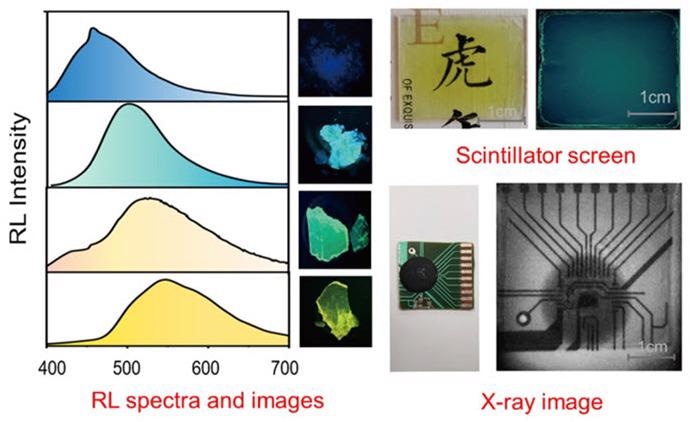X-Ray detection is critical in a variety of situations, including radiation detection, medical diagnostics, and security inspection. Integrating a photodetector with a luminous substance called a scintillator, which generates energy in the form of light, is a common technique to perform X-Ray detection. High-energy X-Ray photons may be converted to low-energy visible light using scintillators.
 Amorphous polymeric scintillators that exhibit multiple radioluminescence colors will contribute to high-resolution X-Ray imaging. Image Credit: Wei et al., doi 10.1117/1.AP.4.3.035002
Amorphous polymeric scintillators that exhibit multiple radioluminescence colors will contribute to high-resolution X-Ray imaging. Image Credit: Wei et al., doi 10.1117/1.AP.4.3.035002
Inorganic materials or heavy metal complexes are frequently used in X-Ray scintillators. These scintillators work well, but they have several drawbacks, including toxicity, difficult preparation, and the expensive cost of rare metal resources.
It is difficult to come up with novel designs for efficient, metal-free X-Ray scintillators, but it is commonly acknowledged that pure organic scintillators have unique benefits over inorganic ones: they are less expensive, more versatile, and easier to make. Nonetheless, recent advances in efficient radioluminescence have mostly focused on small compounds, or monomers, which are often coupled with processability and repeatability difficulties.
Researchers from China’s Nanjing University of Posts and Telecommunications (NUPT) have published a method for making radioluminescent polymeric scintillators with different emission colors. In an amorphous condition, the organic polymers emit a variety of colors from blue to yellow, with high brightness.
Radical copolymerization of negatively charged polyacrylic acid and various positively charged quaternary phosphonium salts gives them their brightness. One of the polymers developed (P2) shows a strong photostability at high X-Ray irradiation doses (27.35 Gy) and a detection limit of 149 nGy s–1, outperforming standard anthracene-based scintillators.
The researchers successfully exploited organic polymeric scintillators for X-Ray radiography, as published in Advanced Photonics. Due to the great processability of these polymeric materials, scientists were able to create a transparent scintillator screen by simply drop-casting them on the quartz plate.
The scintillator screen was then X-Ray imaged using a typical X-Ray test pattern plate to determine the greatest achievable resolution for radiography utilizing this scintillator screen. At an MTF of 0.2, scientists were able to achieve a maximum resolution of 8.7 line pairs (lp) mm-1. These findings show that organic polymers have a lot of potential as scintillator screens for high-resolution X-Ray imaging.
This general and straightforward approach for designing metal-free, amorphous polymeric scintillators with multicolor radioluminescence for high-resolution X-Ray imaging is a milestone signifying the start of a new avenue of research for low-cost, flexible radioluminescent polymeric materials. We anticipate that the design strategy will be widely adopted by the materials science, photonics, optoelectronics, and bioimaging communities.
Qiang Zhao, Professor, Study Corresponding Author, Institute of Advanced Materials, Nanjing University of Posts and Telecommunications
Qiang Zhao has also worked in the State Key Lab of Organic Electronics and Information Displays.
Journal Reference:
Wei, J., et al. (2022) Organic room-temperature phosphorescent polymers for efficient X-Ray scintillation and imaging. Advanced Photonics. doi.org/10.1117/1.AP.4.3.035002.